On the foreshore of Sydney Harbour, not far from the Opera House, is Walsh Bay. It’s had many lives: as an arrival point for early European settlers, home to container terminals and the traditional lands of the Gadigal People of the Eora Nation. It’s now a world-class arts precinct showcasing Australia’s finest theatre, dance and music. Dr Peter Tonkin, one of the architects who worked on the project, looks back on the transformation from rural to industrial to artistic.
The Walsh Bay Arts Precinct involves the adaptive re-use of two extensive heritage listed timber wharves dating from the early 20th century. Situated in a renewed industrial area adjoining the Sydney CBD, the project is a key part of the ‘Cultural Ribbon’ of arts venues along the waterfront from the Opera House. It is a significant addition to the cultural life of Sydney as the home for nine of Australia’s premier arts companies, uniting performance, production and administration in spaces accessible to the public and of the highest technical quality.
The project comprises Pier 2/3 and Wharf 4/5 at Hickson Road in Walsh Bay. Pier 2/3 is a two level wharf structure, built between 1912 and 1923, and prior to the refurbishment, it was Sydney’s last wharf structure to remain in its original maritime use state with minimal subdivision and services. Wharf 4/5 was completed in 1922 and was altered in the early 1980s to accommodate the Sydney Dance Company, Sydney Theatre Company, Bangarra Dance Company and the Australian Theatre for Young People.
The idiosyncratic naming of Pier 2/3 results from the sale of the Pier’s lease by the Ports Authority, the landowner, some years ago, separately from its shore sheds. Thus without its shore sheds, it is referred to as a ‘Pier’ rather than a complete Wharf, still-united with its wharf sheds as is Wharf 4/5.
Links with the surrounding area
Walsh Bay is intrinsically linked to the history and growth of the surrounding areas of Millers Point and Dawes Point. This central part of Sydney, adjoining its initial township of The Rocks, is of national heritage significance for its social and cultural mix, its historic architecture, and as the site of the first European settlement in Australia. This is also the traditional land of the Gadigal people of the Eora nation, and while the site itself is too disturbed for archaeological excavation, contemporary reports confirm its intensive occupation.
Millers Point was always a mixed residential and industrial maritime precinct containing buildings and spaces dating from the early 19th century. Dawes Point is a prominent landmark in Sydney Harbour, the site of the southern abutment and Pylons of the Harbour Bridge, and of Dawes Point Battery, a major and early element in Sydney Harbour’s nineteenth century defences. It was also the site of the colony’s first observatory, set up by Lt. William Dawes who documented much of the Gadigal language.
The colonial era industry in the area included boating, windmills and quarrying. With the expansion of agriculture and a flourishing import and export industry, trade increased the use of waterfront areas, growing as the wealth from the gold rushes during the 1850s boosted Sydney’s economy. As the town grew and trade increased, larger sailing and then steam vessels required the expansion of the privately owned wharves, so that by 1900 there were fourteen finger wharves in Walsh Bay, reaching out to the deep waters.
Public ownership
Unsanitary and makeshift conditions resulting from the small scale private ownership of the wharves during this time was exacerbated by the adjoining conglomeration of overcrowded ‘slum’ dwellings. The outbreak of the Bubonic Plague in 1900 acted as a catalyst for what was a widely-desired reconstruction of the waterfront, providing more efficient shipping and better living conditions for workers.
In 1901, the NSW Government oversaw the creation of the Sydney Harbour Trust and the resumption of the wharves and adjoining properties, in a huge arc from Circular Quay to Balmain around Darling Harbour and White Bay.
The first President of the new Trust on its formation was Robert Rowan Purdon Hickson (1842-1923), an Irish port engineer who emigrated in 1876 and joined the NSW Department of Public Works in 1881. His Engineer in Chief was Henry Deane Walsh (1853-1921), another Irish civil engineer from the Public Works Department, who had emigrated in 1877 and was the man who gave his name to Walsh Bay.
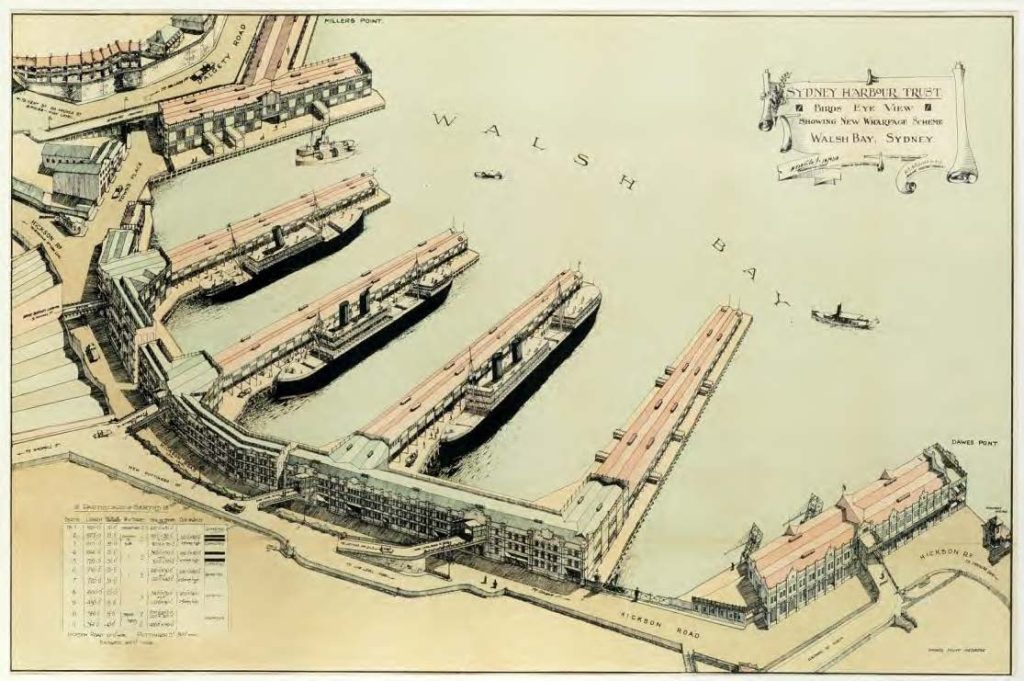
Source Australian National Maritime Museum.
The Trust’s program is captured in a hand-drawn lithograph, showing the sweep of reconstructed waterfront with its integrated railways and roadworks, making an enormous and efficient goods transfer system for Sydney’s great natural harbour, reinforcing its role as Australia’s premier port and a key part of the Asia/Pacific trade routes. Undertaken in stages, and never fully realised, the project wound down in the early 1920s.
Major elements included split level wharves at Darling Harbour, demolished in the 1970s and 80s for container terminals and now reconstructed as Barangaroo, and the Darling Harbour Goods Rail Line, which was abandoned in the 1970s as it missed the container wharves. This area was converted to the Darling Harbour precinct for the 1988 Bicentennial.
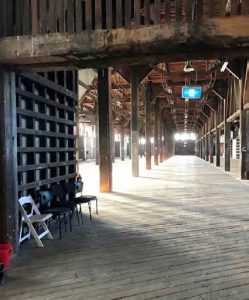
Deep water
Walsh Bay, as the portion of the development with the deepest harbour water and closest to the shipping lanes, was the focus of the project. Construction of the wharves began with the major cliff excavations in 1909 to form Hickson Road, a broad connector wide enough to turn a bullock dray and fit a future rail line, but focused on the future of motor vehicles. It was completed in 1921 with the realignment of Pottinger Street, the upper level connection to The Rocks.
Both Pier 2/3 and Wharf 4/5 were constructed in stages from 1912 to 1923, and are similar in overall conception to the other Walsh Bay wharves: Pier 6/7 was demolished and replaced many years later with a new apartment building over the water. Pier 8/9 was converted to offices in the late 1990s. Each comprises several levels, accessed separately from Hickson Road and from the streets behind The Rocks via bridges over the roadway.
All the wharves originally had almost continuous Shore Sheds linked directly to the Wharf Sheds, and long jetties on timber piles over deep water.
The water depth posed a challenge. Conventional piles for jetty wharves were inadequate. During the late 19th century, Norman Selfe, a highly-inventive local engineer, was experimenting with pile technology to overcome the problem, and his system of spliced hardwood piles was used for the jetties at Walsh Bay, where the water depth approaches 30 metres. The piles were ironbark, and required successive repairs as the timber degraded over time, particularly in the intertidal zone where marine organisms attack the timber.
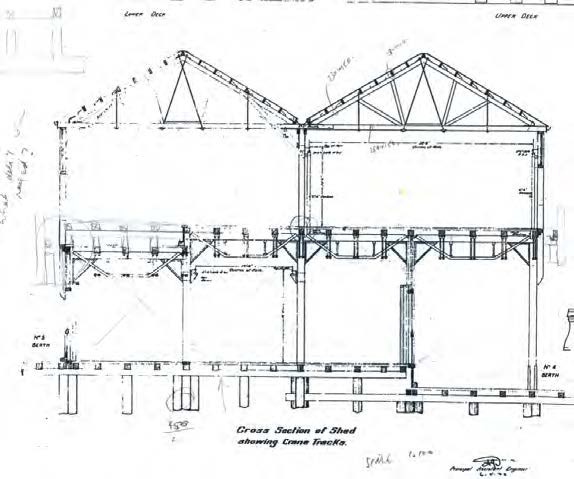
Source: Sydney Harbour Trust.
Innovative use of concrete
Walsh used precast concrete sections to create a rat proof sea wall, which runs under the shore sheds, and was backfilled with the spoil from the excavation forming Hickson Road. Along the roadway to the east are massive sandstone retaining walls up to 15 metres high, and these extend to form terraces allowing the preservation of Victorian era terrace houses lining the streets above.
The wharves have early reinforced concrete aprons all around, 12 metres wide, allowing the circulation of cargo vehicles and the servicing of the berthed ships. The concrete is laid on massive timber beams forming the pile headstocks, and these have survived to the present. The aprons are typically at two levels, allowing a loading from a truck direct to the wharf shed floor on one side or level vehicle access on the other.
Ramps at the seaward end connect the two levels and allow vehicle circulation all around. Both the shore and the wharf sheds are constructed of timber, possibly due to post-WW1 shortages of steel, which had by the early 20th century replaced the Victorian era use of heavy structural timber. The shore sheds are faced along Hickson Road with elegantly detailed free-style classical facades in brick and sandstone, creating a suitable civic frontage for the industrial uses behind.
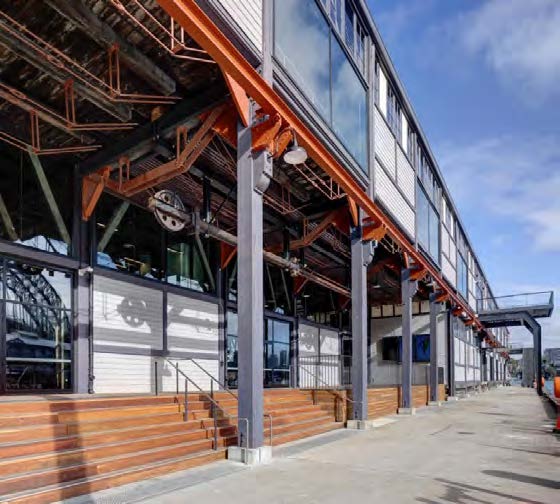
Photo: Brett Boardman.
They remain lively and elegant, enriching the subtle curve of the roadway as a generous city boulevard. The wharf sheds are up to 180 metres long and 25 metres wide, each resting on hundreds of timber piles down to the harbour bed. Their simple post and beam timber structures are scaled to the available lengths of the massive timbers used, with a vertical and horizontal module of 20 feet (6.1m), allowing the required clear spans for cargo movement, and the internal height for the stacking of crates or bales.
To support the very heavy loads imposed by the stacked cargo and the vehicles used to transport it, each timber beam is reinforced with a forged steel ‘strongback’, a reversed tension tie which allows a doubling of the load carried with a significant reduction in deflection.
The facades incorporate a distinctive ‘checkerboard’ pattern based on the modular structure. Large sliding cargo doors alternate with weatherboard infills along their length, with timber-framed multi-paned windows and fibre cement panels alternating above.

The Walsh Bay wharves continued in busy operation for cargo shipping throughout the interwar years, and were extensively used for troop movements and supplies during World War 2. After the war, coastal shipping, already in decline, was further reduced, while ships grew larger and required bigger berths.
By the 1960s, longshore wharfage was replacing the Hickson-designed finger wharves along Darling Harbour, and the Walsh Bay wharves began a long period of inactivity. The 1970s saw a crucial decision by the Maritime Services Board, the successor to the Sydney Harbour Trust, that Walsh Bay could not be redeveloped as longshore wharves for container vessels.
Modern usage
In 1985, the then Premier of NSW announced the adaptation of the upper level of Wharf 4/5 as the home of the new Sydney Theatre Company, and the reuse of the lower levels for arts companies followed in the 1990s. This use was reinforced with the construction of the Roslyn Packer Theatre for the STC opposite Wharf 4/5, and the redevelopment of the former Darling Harbour container wharves for the new Barangaroo commercial and residential precinct, still underway, and including a new underground metro station.
Pier 2/3 and Wharf 4/5 have been transformed for the new Walsh Bay Arts Precinct, a project conceived and funded by the NSW Ministry of the Arts through Create NSW, delivered by Infrastructure NSW and constructed by Richard Crookes Constructions from 2019 to 2022.
The upper level of Wharf 4/5, occupied since 1986 by the Sydney Theatre Company, has been completely reworked to house new paired theatres and production spaces, as well as bars, restaurant and administration areas, to the design of Hassell Architects. The lower levels of Wharf 4/5 housed arts activities for many years, with Bangarra Dance Theatre, Gondwana Choirs, Sydney Philharmonia Choirs, The Song Company and Sydney Dance Company all located in the lower shed of the structure, and each including production, administration, rehearsal and performance venues.
Extensive refurbishment, designed by Tonkin Zulaihka Greer (TZG), was undertaken to reinvigorate these spaces and upgrade them to meet the required technical standards and to accommodate the reconfigured spaces above. This was carried out as a separate project. The new Wharf 4/5 opened in 2021.
Pier 2/3, previously undeveloped, has been transformed (by TZG) to house the Australian Chamber Orchestra, Australian Theatre for Young People and Bell Shakespeare. The facilities include multiple theatres, rehearsal studios, production workshops, function spaces and administrative offices, as well as an acoustically-rich concert chamber.
With each of the wharves similar in volume to a 40 storey timber skyscraper laid on its side over water, the project presented a high level of design and constructional challenge. External modifications to the buildings were minimised, with the most prominent change being the introduction of external balconies and stairs that provide required egress and upper-level breakout spaces. Designed as an interpretation of the original shipping gantries, they are complemented by external glass lifts that minimised internal demolition. Extensive re-piling and timber repair required the sourcing of appropriate hardwood and careful craftsmanship.
Internally, in Pier 2/3, the architecture celebrates the original volumes and structure. Massive timber storey posts and trusses are retained, as are the remnant iron and steel ‘strongbacks’. Circulation, event and foyer spaces are left in their ‘raw’ state to enable the textures of the original timber to remain visible.
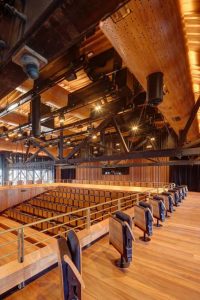
Photo: Brett Boardman.
The performance and rehearsal spaces, which required significant acoustic separation and air conditioning, are pulled away from the single-skin weatherboard facades as separate volumes. Their cladding, in deep bronze anodised aluminium, recalls shipping containers or the original weatherboards. At high level, walls are treated in mirror, giving the appropriately theatrical illusion of the original and eloquent structure continuing beyond.
Environmentally Sustainable Design (ESD) initiatives, integral to the project, include:
- Adaptive re-use and repurposing of original fabric to reduce embodied energy.
- Harbour Heat Rejection system which minimises consumption of energy and water.
- Target 30% reduction of energy demand through a 489kW PV system, passive design and efficient fittings.
Over the project’s long and complex journey, TZG, along with the NSW Government client, the arts companies, technical consultants and the builders, set in place a collaborative approach to ensure a successful outcome for all stakeholders.
There are many stand-out attributes that make the project
noteworthy. Here are a few:
- It is the largest adaptive reuse of a heritage building to date in Australia, and one of the largest globally. As such, it demonstrates how our cultural and technical heritage can be conserved and brought into active contemporary use, thus linking the past to the future in a way that is both exciting and responsible.
- The adaptive reuse of Pier 2/3 and Wharf 4/5 at Walsh Bay brings significant heritage and environmental benefits, reducing embodied energy, capturing tonnes of carbon and avoiding waste.
- Importantly, this careful and responsible reuse of historic structures has brought no sacrifice of quality. Each venue has been tailored to the specific functional and acoustic requirements of the users.
- The Precinct provides a wide range of venues, each with its own special character, each a recognisable part of a unique, historic timber structure in an equally unique setting. They include a flat-floor event space for upwards of 1500 guests with panoramic water views on all sides, an intimate 200 seat drama theatre focussed on young people’s performance, a flexible performance/rehearsal space seating up to 400, a suite of voluminous dance studios with natural ventilation, and a concert hall for 350 with acoustics recognised as world-leading that also captures views of Sydney Harbour.
- The various journeys through the building, of back-of-house production and administrative workers, performers, audience, and interested public, bring people into an architectural dialogue with historic industrial construction and contemporary architecture, as well as a close-up engagement with Sydney’s unique harbourfront.



